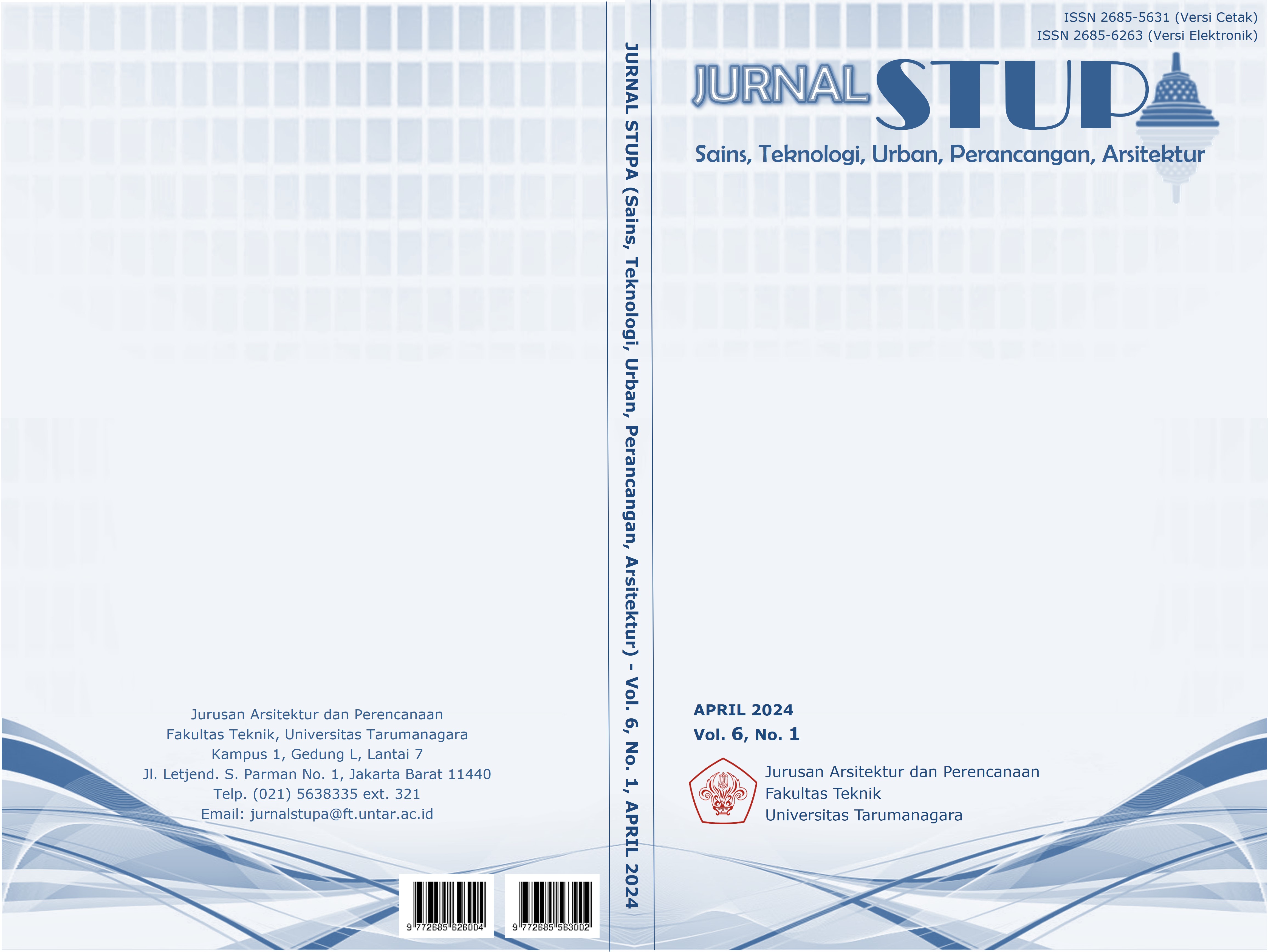MENERJEMAHKAN EKSPRESI DEPRESI REMAJA MENJADI VOLUME KERUANGAN MENGGUNAKAN TEORI SEQUENCE OF EVENTS
Main Article Content
Abstract
The adolescent phase is a phase of self-discovery and identity development to enter a certain social sphere. The phenomenon that occurs in this adolescent phase is that many adolescents experience depression due to self-discovery and inappropriate decision making. The lack of a place in the form of a free environment as a place to mingle with friends and get emotional support and a place of escape from a toxic environment, it requires novelty to the function of space that adjusts the mental condition of adolescents both psychologically and socially, therefore this research raises the issue of spatial sequence for depressed adolescents. The function of the space is developed with spatial elements translating the mental expression of adolescents and used as an interactive element as a form of understanding adolescents. The research method uses a descriptive method that describes literature studies collected qualitatively and quantitatively either through journals, books, articles, experiences, research results, or questionnaires. Sequence of Events as a design method translates the narrative taken through a movie montage which is converted into a spatial volume with Luigi Moretti's theory. The result of the design is the volume of space that affects the spatial experience of the narrative space formed by the montage. Narrative space uses architectural elements to translate the size and scale used to fulfill a unique and interactive spatial experience that encourages teenagers to understand their mental state well.
Keywords: adolescent depression, montage, narrative space, psychosocial
Abstrak
Fase remaja merupakan fase mencari jati diri dan mengembangkan identitas untuk masuk ke lingkup sosial tertentu. Fenomena yang terjadi pada fase remaja ini adalah banyak remaja yang mengalami depresi karena pencarian jati diri dan pengambilan keputusan yang kurang tepat. Kurangnya wadah berupa lingkungan yang bebas sebagai tempat bercengkerama bersama teman dan mendapatkan emotional support serta tempat pelarian dari lingkungan yang toxic, maka dibutuhkan kebaruan terhadap fungsi ruang yang menyesuaikan kondisi mental remaja baik secara psikis maupun sosial, karena itu penelitian ini mengangkat isu spatial sequence untuk remaja yang depresi. Fungsi ruang dikembangkan dengan elemen keruangan menerjemahkan ekpresi mental remaja dan dijadikan elemen interaktif sebagai salah satu bentuk pemahaman remaja. Metode penelitian menggunakan metode deskriptif yang menjabarkan studi literatur yang dikumpulkan secara kualitatif maupun kuantitatif baik melalui jurnal, buku, artikel, pengalaman, hasil riset, atau kuisioner. Sequence of Events sebagai metode perancangan menerjemahkan narasi yang diambil melalui montase sebuah film yang diubah menjadi volume keruangan dengan teori Luigi Moretti. Hasil perancangan adalah volume ruang yang mempengaruhi pengalaman keruangan dari narrative space yang terbentuk oleh montase tersebut. Narrative space menggunakan elemen arsitektural untuk menerejemahkan ukuran dan skala yang digunakan untuk memenuhi pengalaman keruangan yang unik dan interaktif sehingga mendorong keingin remaja memahami kondisi mentalnya dengan baik.
Article Details

This work is licensed under a Creative Commons Attribution-NonCommercial-ShareAlike 4.0 International License.
This work is licensed under a Jurnal Sains, Teknologi, Urban, Perancangan, Arsitektur/ STUPA Creative Commons Attribution-NonCommercial-ShareAlike 4.0 International LicenseReferences
Aisyaroh, N., Hudaya, I., & Supradewi, R. (2022). Trend Penelitian Kesehatan Mental Remaja Di Indonesia Dan Faktor Yang Mempengaruhi: Literature Review. Scientific Proceedings of Islamic and Complementary Medicine, 41-51. doi:10.55116/SPICM.V1I1.6
Carroll, N. (1985). Daedalus. The Power of Movies, Vol. 114(No. 4), 79-103. Retrieved from The : www.jstor.org/stable/20025011
Chandy, L., & MacKenzie, E. J. (2021). On My Mind: How adolscents experience and percieve mental health around the world. The State of the World's Children 2021, 72. Retrieved from https://www.unicef.org/reports/state-worlds-children-2021
Einstein, S. M., Boise, Y. A., & Glenny, M. (1989). Assemblage. Montage and Architecture, 10, 111-131. Retrieved from http://www.jstor.org/stable/3171145
Kubala, K. (2023, Mei 31). PsychCentral. (N. Lovering, Editor) Retrieved from What Are the 4 Stages of Depression?: https://psychcentral.com/depression/stages-of-depression
Legg, T. J. (2021, Febuari 18). healthline. (B. Krans, & S. Faris, Editors) Retrieved from Teen Depression: https://www.healthline.com/health/adolescent-depression
Mediastika, C. E. (2016). Understanding Empathic Architecture. Journal of Architecture and Urbanism, 40(1), 1. doi:10.3846/20297955.2016.1165385
Molinari, C. (2021). Sequences in architecture: Sergei Ejzenštejn and Luigi Moretti. The Journal of Architecture, 1-19. doi:10.1080/13602365.2021.1958897
Nooraddin, H. (2020, Juli 25). Children City Architecture. Advances in Social Sciences Research Journal, 7(7), 768-796. doi:10.14738/assrj.77.8722
Putra, D., & Lukito, Y. N. (2018, Juni). Architect and Emphaty: The Importance of Human Experience in Architectural design. International Journal of Built Environment and Scientific Research, 2 (1), 47-54. doi:10.24853/ijbesr.2.1.47-54
Shah, S. M., Dhaheri, F. A., Albanna, A., Jaberi, N. A., Eissaee, S. A., Alshehhi, N. A., Betancourt, T. S. (2020, January 14). Self-esteem and other risk factors for depressive symptoms among adolescents in United Arab Emirates. Plos One, 1-16. doi:10.1371/journal.pone.0227483
Tim Riskesdas 2018. (2018). Laporan Riskesdas Provinsi DKI Jakarta. Jakarta: Lembaga Penerbit Badan Penelitian dan Pengembangan Kesehatan.



